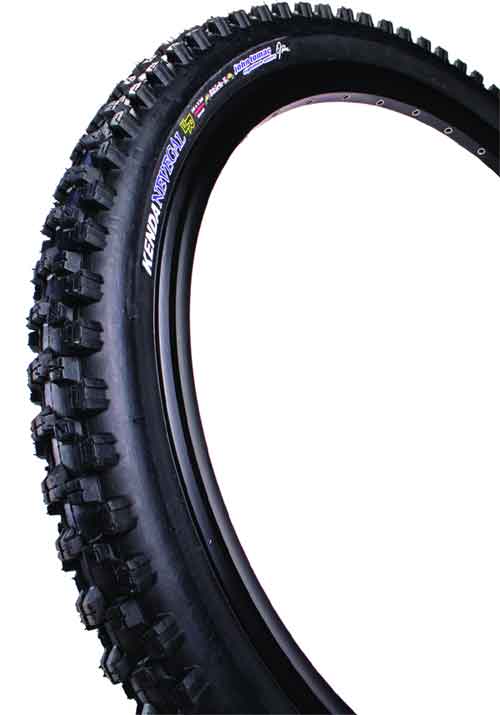All About All-Terrain Wheelchair Tires By Sarah Werner
 One of the experiences I most missed when I had to make the transition from crutches to a wheelchair was hiking. There’s nothing quite like being surrounded by the natural landscape, whether it’s forest, field or mountainside, far from the noise of cars.
One of the experiences I most missed when I had to make the transition from crutches to a wheelchair was hiking. There’s nothing quite like being surrounded by the natural landscape, whether it’s forest, field or mountainside, far from the noise of cars.
I am a fairly strong person, and I have a good chair, but I quickly found that my equipment was woefully inadequate on any unpaved terrain. I also didn’t have thousands of dollars to plunk down for a purpose-built all-terrain wheelchair, so I started to do some research into alternatives.
One of the easiest (and least expensive) ways to get off the paved path is to install all-terrain rear wheels on your wheelchair. The standard 1 inch wheelchair tire sinks easily into grass and dirt and has a hard time gripping uneven surfaces like gravel. In this post I’ll talk a little bit about different all-terrain tires as well as offer some advice on casters that can complement rear wheels.
A few things are important to take into account when you are considering which kind of tire and wheel setup best suits your needs. It used to be that if you wanted a mountain bike tire for your wheelchair, you needed 26 inch rims. I have found recently that there are a variety of mountain bike tires available in the more standard 24 inch wheelchair rim size.
If you decide to go with a larger diameter wheel than what you have on your current chair, it is imperative that you compensate for the increased rear height by getting larger-diameter caster wheels or moving the caster axle to a lower hole.
Every time you make an adjustment that involves the wheels, you must make sure to maintain the center of gravity in the chair. Seat height and back height may also need to be adjusted to compensate. For all of these reasons I was grateful that I found what I needed in the standard 24 inch diameter rim.
It’s also important to note that you cannot put a 2 inch wide tire on a standard 1 inch wheelchair rim and vice versa. It won’t fit right. You need to have rims that are made for wider tires, usually with a width range of 1.75-2.5 inches. When I was doing this research for myself, I was already in the market for new rims to replace the worn-out mag wheels that came with the chair. Sportaid sells Sun rims (both 24 inch and 26 inch) for tires 1.75-2.5 inches wide, which were perfect for me.
They come with either 1.96 inch or 2.5 inch wide tires. I went with the 2.5 inch ones, which are Kenda Knobby tires originally designed for downhill mountain bikes.
They are made to grip firmly on dirt, mud, and rock. They are not made for speed, as I quickly learned. When ordering new wheels, you might also need new axles if the hub width is different than your current rear wheels. Hub widths are listed in the product information for wheels, and you can measure your current hub width as seen below.
The Kenda Knobby tires were really bad ass in appearance, but I found that they were harder to propel than my thin tires. They grip the dirt and are wide enough for sand, but I often needed a push when going up any kind of incline. They perform best in the snow and ice, gripping like no other tire I’ve had. The tall tread is perfect for this winter weather, but it is almost impossible to build up any kind of speed.
As someone who values being self-sufficient and going fast, I didn’t really like needing extra assistance on hills. After a few weeks of trying to get by, I swapped out my knobby tires for some really sweet Continental Ride Tour tires—made for hybrid bikes—that are 24 x 1.75 inches and fit my nice new Sun rims. These hybrid tires are wide enough for grass, dirt and gravel, while also being fast on paved surfaces. They have become my everyday tire of choice, and I haven’t noticed much of a difference in the handling of the chair between these and 1 inch tires. Though I have not tried them, I suspect that 2 inch standard mountain bike tires (not the super-knobby downhill tires) would work almost as well as my Connie hybrid tires.
While having sturdy rear wheels is crucial for navigating unpaved surfaces, it’s the caster wheels that can really make life miserable when they dig in to grass and mud. I’ve found that soft roll casters, which are 1.5 inches wide, work fairly well in grass and packed dirt. Soft roll casters are rounded, so that on paved surfaces, only the very middle touches the ground for minimal drag.
On soft surfaces, the whole width of the caster makes contact, spreading out the weight of the front of the chair. Similar to what was mentioned above, when you have tires with a higher tread pattern, like the Kenda Knobbys, you may need to compensate by moving the caster wheel to a lower axle hole or getting a larger diameter caster.
On muddy or gravel surfaces even wide casters can dig in, and this is when a FreeWheel Wheelchair Attachment can come in quite handy, though it’s a bit pricey (https://www.gofreewheel.com).
I hope you’ve found this helpful and are ready to go on your own adventure, whether it’s to your local park or a national forest!











You must be logged in to post a comment.